赛默飞世尔哈克流变仪总样本
赛默飞水质分析仪手册
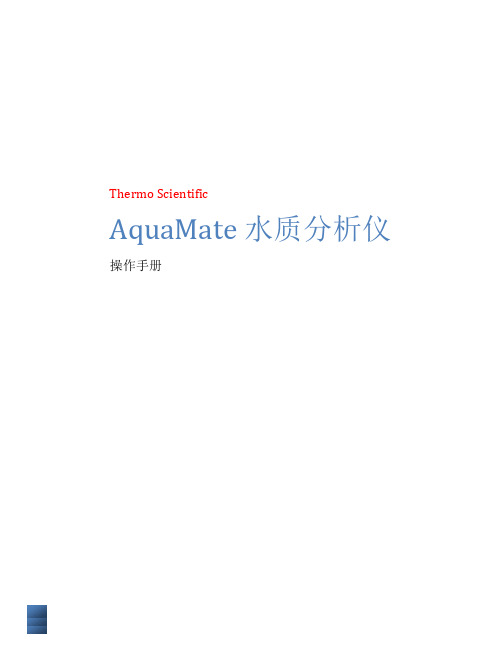
操作手册
Байду номын сангаас
Thermo Scientific
目录
前言 ....................................................................................................................................................... 6 安全和注意事项 ............................................................................................................................ 6 第一章 仪器基础信息 .................................................................................................................... 7 1.1 仪器组成 ............................................................................................................................ 7 1.1.1 接口 ........................................................................................................................ 7 1.1.2 键盘 ...................................
赛默飞流变仪使用指南
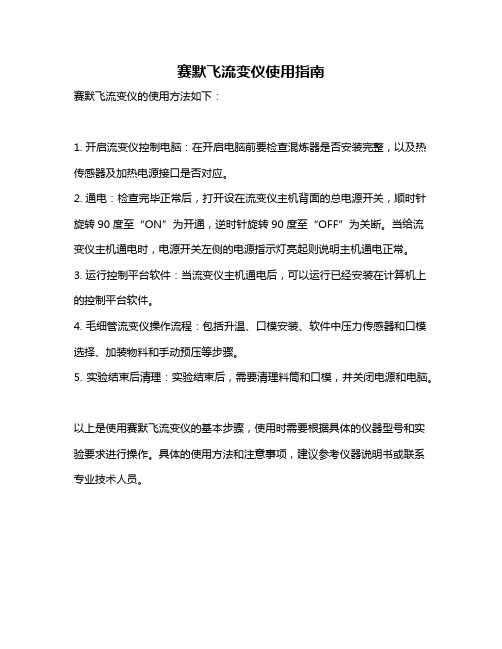
赛默飞流变仪使用指南
赛默飞流变仪的使用方法如下:
1. 开启流变仪控制电脑:在开启电脑前要检查混炼器是否安装完整,以及热传感器及加热电源接口是否对应。
2. 通电:检查完毕正常后,打开设在流变仪主机背面的总电源开关,顺时针旋转90度至“ON”为开通,逆时针旋转90度至“OFF”为关断。
当给流变仪主机通电时,电源开关左侧的电源指示灯亮起则说明主机通电正常。
3. 运行控制平台软件:当流变仪主机通电后,可以运行已经安装在计算机上的控制平台软件。
4. 毛细管流变仪操作流程:包括升温、口模安装、软件中压力传感器和口模选择、加装物料和手动预压等步骤。
5. 实验结束后清理:实验结束后,需要清理料筒和口模,并关闭电源和电脑。
以上是使用赛默飞流变仪的基本步骤,使用时需要根据具体的仪器型号和实验要求进行操作。
具体的使用方法和注意事项,建议参考仪器说明书或联系专业技术人员。
赛默飞液质联用色谱仪参数

赛默飞液质联用色谱仪参数
赛默飞液质联用色谱仪是一种高级仪器,具有多种参数和功能。
以下是一些常见的赛默飞液质联用色谱仪的参数:
1. 柱温控制,色谱柱温度对色谱分离的影响非常重要。
赛默飞
液质联用色谱仪通常具有精确的柱温控制系统,可在分析过程中维
持恒定的柱温。
2. 流动相梯度控制,赛默飞液质联用色谱仪能够精确控制流动
相的梯度,从而实现复杂样品的分离和分析。
3. 检测器灵敏度,赛默飞液质联用色谱仪配备了高灵敏度的检
测器,通常包括紫外-可见(UV-Vis)检测器、荧光检测器、质谱检
测器等,以满足不同样品的分析需求。
4. 色谱柱,色谱柱是色谱分离的关键组成部分,赛默飞液质联
用色谱仪通常支持多种类型的色谱柱,如反相柱、离子交换柱、亲
和柱等,以适应不同的分析需求。
5. 数据处理软件,赛默飞液质联用色谱仪配备了先进的数据处
理软件,可以对色谱分析得到的数据进行快速、准确的处理和解释。
以上是一些常见的赛默飞液质联用色谱仪的参数,这些参数可
以帮助用户进行高效、精确的样品分析和检测。
希望这些信息能够
对你有所帮助。
赛默飞世尔 BigDye XTerminator

快速参考手册BigDye XTerminator™ Purification Kit货号:4376486,4376487,4376484,4376485本操作说明提供了BigDye XTerminator™ Purification Kit的简要操作指南。
更详细信息,请至赛默飞世尔官方网站下载英文版说明书:https:///TFS-Assets/LSG/manuals/cms_042772.pdf产品概述:BigDye XTerminator™Purification Kit用于去除循环测序反应的组分如盐离子、未结合的染料和dNTPs等以防止它们与染料标记的延伸产物一同进样至测序仪。
BigDye® XTerminator™试剂包含XTerminator™Solution和SAM™Solution两个组分,两者可以按顺序分别加入反应板或者预混后一起加入反应板。
订购信息:注意事项:•重要:在移液过程中,请保持试剂充分混匀。
•为了得到最好的结果,请按照第5页的“测序反应指导”进行操作。
•从XTerminator™ Solution的试剂瓶中吸取试剂时注意:-使用宽口的移液枪头(口径大于1.0 mm);-避免从靠近液体表面处吸取试剂。
•吸取SAM™ Solution和“操作步骤二”的预混液时,使用常规的移液枪头。
•为了达到最好的效果,振荡反应板时请使用推荐的振荡仪并按照说明书上的步骤进行操作。
•当您将反应板加载至测序仪器时,不要对含有BigDye XTerminator™Solution的样本进行加热变性或使用Hi-Di™ Formamide。
实验前准备:•观察SAM™Solution。
如果看到试剂里有沉淀,需先37℃加热并混匀以让其溶解。
使用前将试剂降至室温。
•完全混匀SAM™ Solution。
•如果您使用直接进样至测序仪的方法,请确认您的仪器已经安装了对应的BDx run module(参考详细版英文说明书BigDye XTerminator™ Purification Kit User Guide (Pub. No. 4374408))。
旋转流变仪 Haake Mars Ⅲ

一般程序必选 Lift control 试验程序示例:
、Temperature setting
、Show data window
三个选项。
Lift control
——控制测试 Gap (变温试验必须勾选 Thermo gap)
Temperature setting
——控制试验温度
Oscillation Frequency Sweep ——振荡试验频率扫描(测试模式之一)
2.按信号类型分类: 稳态旋转(Steady Rotation): 蠕变/恢复(Creep/Recovery) 测定物质的粘性和弹性特性的CS测量模式,例如用于零剪切粘度的 测定或者突变寿命的评估标准。 应力增加/减少(Stress Growth/Decay) 测定流动曲线的时间特性和稳定状态的CR 测量模式。
有关粘度现象的流动特征(Flow properties regarding viscosity behavior):
牛顿流体(Newtonian): 粘度将不随剪切速率和剪切应力发生改变的物质特性。 (HAAKE 落球粘度计,Höppler 系统)
假塑性(Pseudoplastic): 粘度将随剪切速率和剪切应力降低的物质特性。 (大多数的物质现象)
1.断开软件和主机的信号连接,单击
;
2.关闭主机控制器后面电源开关;
3.关闭水浴器后面电源开关;
4.关闭空压机的两个按钮:电源开关/过载保护器。
2.2 更换温控系统须知
流变仪 MARSⅢ配有三套温控系统:CTC 炉子、半导体控温同心圆筒、半导体控温平锥板。 三套系统在更换时,必须先断开主机的链接和电源、循环器电源,方可更换。
同样的工作可以利用 CD 模式来完成,但是中断评判的方法会更快! 说明:将太多的精力放在对物质的线性粘弹区的评测上也许是不值的,由于在同样 条件下测量结果的比较可能包含有需要的信息。
thermo液质联用仪使用手册
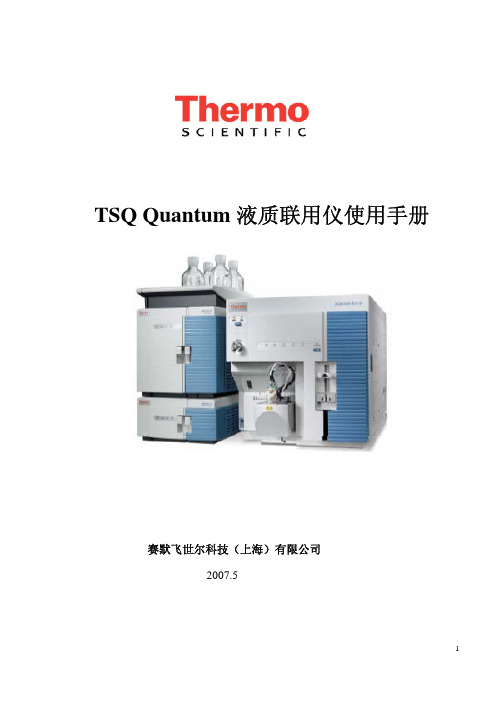
ESI 模式通常产生由单电荷离子组成的质谱图,但是还要取决于被分析物的结构和溶剂类 型。当产生多电荷离子时,质谱谱图结果可进行数学转换从而表示样品的分子量。
ESI 模式将溶液内的离子转换成气态。许多此前并不适合质谱分析的样品(例如,热稳定性差的化合 物或者高分子量的化合物)可以通过 ESI 模式进行分析。ESI 可用于分析任意在溶液中已经预成离子的极 性化合物,预形成离子可以包括加合离子。例如聚乙二醇可以在有醋酸铵存在的溶液中分析出来,因 为,NH4+和聚合物中的氧原子可以形成加合离子的形式。由于多次放电,使用 ESI,TSQ Quantum Discovery MAX 质谱仪可以分析分子量超过 100,000 u 的化合物。ESI 特别适用极性化合物的质谱分析, 包括生物聚合物(例如,蛋白质,肽,糖蛋白类和核苷)、药物及其代谢物和工业聚合物。
A-2
使用化学干粉制备聚酪氨酸–1, 3, 6 调谐校准溶液...................................................... A-3
A.2 利血平溶液 ............................................................................................................................... A-4 利血平储备溶液 ............................................................................................................. A-4 利血平试样溶液 ............................................................................................................. A-4
赛默飞生命科学质谱-ThermoFisherScientific
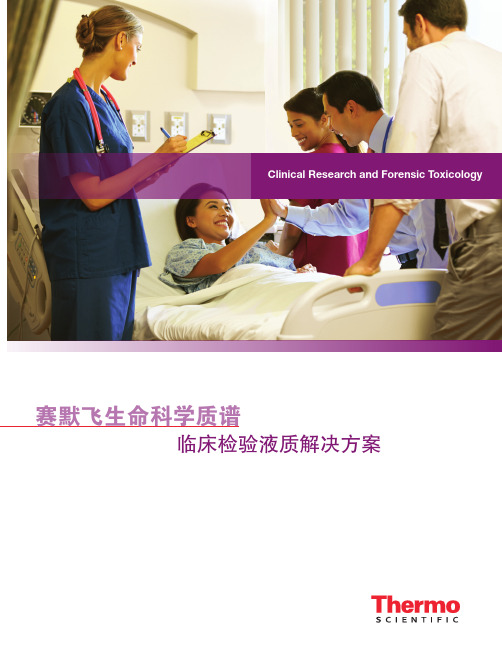
TraceFinder9............................................. 11............................................................ 15....................................... 20............... 24 (28)....................................... 31............................................................... 34 (37).................................... 40................................. 46................................................... 49 (55)......................................................... 60 (62) (69)内源性激素检测雌酮和雌二醇的全自动在线样品前处理及三重四极杆LC-MS/MS 定量分析方法采用 TurboFlow 技术串联三重四极杆质谱定量分析人血清中的睾酮神经递质类化合物分析LC-MS/MS 与柱前衍生法用于脑脊液和脑微透析液中神经递质类物质的代谢靶标分析血浆游离型甲氧基肾上腺素类物质的全自动在线样品前处理及液相色谱-串联质谱技术定量分析方法维生素检测采用 TSQ 三重四极杆质谱仪定量分析血浆中单羟基及双羟基维生素 D 免疫抑制类药物检测联合 Prelude-SPLC 系统和 TSQ 质谱仪进行全血中免疫抑制类药物的定量分析方法采用TurboFlow HPLC-MS/MS 串联质谱定量分析血浆中的霉酚酸采用三重四极杆质谱仪定量分析干血点样品中的免疫抑制剂治疗药物监测尿液中6种阿片类和14中苯二氮卓类药物的三重四极杆LC-MS/MS 高通量定量分析抗抑郁和抗精神病药物的全自动在线样品前处理及三重四极杆LC-MS/MS 定量分析方法人血浆中 17 种抗癫痫药物及其代谢物的三重四极杆 LC-MS/MS 定量分析尿液中阿片类药物低至 ng/mL 水平兼具高分辨率高质量精度的质谱定量分析方法全面毒物药物筛查尿液中多种药物的全自动在线样品前处理及串联质谱筛查与定量方法采用高分辨质谱和简化的高效筛查软件对尿液中的多种药物进行法医学筛查附录 目录临床检验工作流程用于临床检验的样品通常具有基质复杂、干扰物多、待分析化合物浓度低等特点,大量的样品检测任务使日常检测工作变得异常困难,因此专为临床检验提供一个适用于高通量样品分析的工作流程显得尤为重要。
Thermo Scientific HAAKE RheoStress6000流变仪说明书
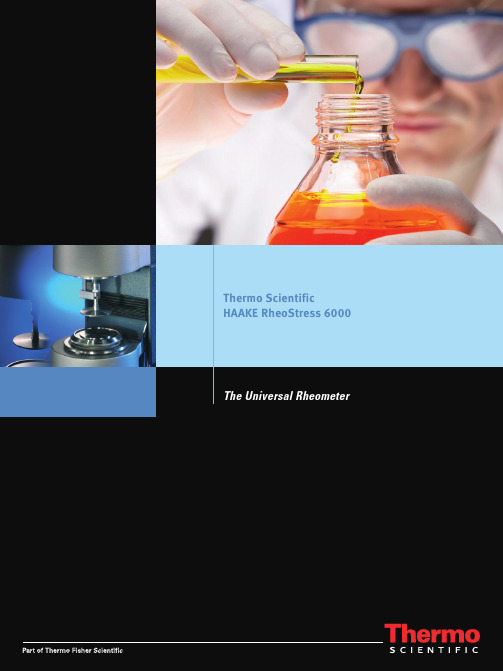
As a pioneer in the fi eld of rheology, we are well-known for our leadingHAAKE viscometer and rheometerlines. These instruments preciselyanalyze a materials‘s rheologicalproperties, temperature-relatedchanges, and the material’sprocessability.The Thermo Scientifi c HAAKERheoStress 6000 is the latestgeneration in the successfulRheoStress series, which is focusedon standard applications in research& development and quality control.The HAAKE RheoStress 6000 is fullycompatible with existing accessoriesof previous RheoStress modelssuch as temperature controlunits, measuring geometries andapplication oriented measuringcells. The new modular HAAKERheoStress 6000 combinesproven technology plus the latestinnovations from the high endThermo Scientifi c HAAKE MARSrheometer. This makes it easier toupgrade to the new generation inRheology without making a hugeinvestment. Thanks to the ThermoScientifi c HAAKE MARS technologyinside, our customers can nowbenefi t from the latestdevelopments in user-friendlymeasuring software and fi rmware.Thermo ScientificHAAKE RheoStress 6000Selection of HAAKE RheoStress models:HAAKE RheoStress 100(1992)HAAKE RheoStress 150(1997)HAAKE RheoStress 6000(2007)2Thermo ScientificHAAKE RheoStress 6000 DesignOptional display/control unit. Monitoring data online even without a PC.The display/control unit of the HAAKE RheoStress 6000facilitates manual operation of lift movement and gap setting aswell as starting measuring and evaluation jobs with or without a PC. The colour display monitors rheological and instrument-specifi c data online.* DE 10 2004 050 753 A1; US 7,181,956 B2Fixed measuring head consisting of:• Drag cup motor with the lowest available inertia(10µNms2)• High resolution optical encoder (12 nrad)• Patented 4th generation air bearing system*• Temperature-compensated, normal-force sensor, based on strain-gauge technology for positive and negative normal force measurements Adapter for upper measuring geometriesReceiver for temperature control units and application oriented measuring cells Compact design by one-column aluminum framewith integrated controland power electronicsGlass plate withhigh resistance againstchemicals for easy cleaning34Universal Temperature Control Unit (UTC)The UTC consists of a universal controller box to regulate different temperature control units for cone and plate measuring geometries – Peltier as well as electrical. A Peltier unit covering a temperature range from -60°C up to 200°C enables quick and accurate responses to temperature changes. The electricaltemperature control unit, comprising a lower and an upper heater, can be converted to a measuring chamber with a tempered glass ring. This allows measurements up to 500°C under visual control and inert gas.Liquid temperature-controlled unitsA temperature control unit for cone & plate measuring geometries and two units withdifferent coaxial cylinder diameters are available. Liquid temperature-controlled units require either a circulator or cryostat and a bath liquid specifi c to the application. The Thermo Scientifi c product portfolio is based on many years of experience in temperature control to ensure a fi t with your requirements.Liquid temperature-controlled unit for coaxial cylindersPowerful Thermo Scientifi cHAAKE Phoenix IItemperature control unitto be used for liquidtemperature controlled unitsElectrically heated temperature control units: upper cone heating system, cylinder and lower plate unit5Our comprehensive accessory portfolio containscoaxial cylinders, plate/plate and cone/plate measuring geometries, custom-tailored dimensions, and made of various materials. Standard titanium measuring geometries have a low mass and therefore a low inertia. For measurements at higher temperatures, geometries with a ceramic shaft are available. Thesegeometries are characterized by a reduced heat transfer to the measuring head and a limited temperaturegradient within the sample. To avoid sedimentation or slippage, measuring geometries with serrated or sand-blasted surfaces are available. Disposable coaxial cylinder and plate/plate measuring geometries are available for cross-linking and curing materials.TypeShear rate (s -1) standardShear rate (s -1) high shear optionRecommended viscosity range (mPas)**Double gap cylinder system DG410.007 - 11 41534 2450.5 - 10 000Cylinder Ø 40 mm ISO 3219Z40 DIN 0.001 - 1 9315 793 5 - 100 000Cylinder Ø 20 mm ISO 3219Z20 DIN 0.001 - 1 9315 79350 - 1 000 000Cylinder Ø 10 mm ISO 3219Z10 DIN 0.001 - 1 9315 793500 - 10 000 000Cylinder Ø 41 mm DIN 53018Z410.002 - 3 50010 50010 - 100 000Cylinder Ø 38 mm DIN 53018Z380.001 - 1 4004 20030 - 500 000Cylinder Ø 31 mm DIN 53018Z310.0005 - 6601 98050 - 1 000 000Profiled cylinder Ø 38 mm DIN 53018Z38/S 0.001 - 1 5004 50050 - 100 000Disposable cylinder Ø 41 mm ISO 3219 Z41DIN/E 0.001 - 1 9315 79310 - 100 000Disposable cylinder Ø 25 mm ISO 3219 Z25DIN/E 0.001 - 1 9315 79350 - 1 000 000High shear cylinder 25 µm gap HS250.1 - 69 200207 600 5 - 100High shear cylinder 100 µm gap HS1000.1 - 15 00045 000 5 - 100Double cone Ø 60 mm, 1° angle DC60/10.006 - 9 00027 000 1 - 50 000Cone Ø 60 mm, 1° angle*C60/10.006 - 9 00027 000 2 - 100 000Cone Ø 35 mm, 1° angle*C35/10.006 - 9 00027 000100 - 1 000 000Cone Ø 20 mm, 1° angle*C20/10.006 - 9 00027 0001 000 - 1.0 E+08Plate Ø 60 mm PP600.003 - 4 70014 100 2 - 100 000Plate Ø 35 mm PP350.002 - 2 7008 100100 - 1 000 000Plate Ø 20 mmPP200.001 - 1 5704 7101 000 - 1.0 E+08Plate Ø 35 mm serratetd PP35/S 0.002 - 2 7008 100100 - 1 000 000Plate Ø 20 mm serratetdPP20/S0.001 - 1 5704 7101 000 - 1.0 E+08Measuring Geometries for Thermo Scientific HAAKE Rheometers6Selection of measuring geometriesHigh-temperature geometries with ceramic shaft at different diametersTitanium geometries with measuring plate cover with same diameter for optimized gap fi lling; sample cover with integrated solvent trapSelection of special measuring geometrieswith serrated surfaces to prevent slippage, with helical groovings to prevent sedimentation, vane rotors and rotors with glass coversCoaxial cylinders according to DIN 53019 in different sizes7Pressure cellDifferent versions of pressure cells for pressuresup to 400 bar and temperatures up to 300°C areavailable. A Hastelloy® version can be used withcorrosive samples.Application examples:Crude oil, drilling fl uids, foodUV cellFor tests on UV-hardening materials UV cells areavailable: a standard version and an individualmeasuring cell with freely confi gurabl e distancesfor optical components such as light guides,condensors and glass plates.Application examples:Coatings, dental material, contact lensesMeasuring cell for construction materialsA special measuring cell with a fl exible profi le formeasurements on building materials is offered.Thanks to the interchangeable profi le lamellas themeasuring cell can be easily and quickly adaptedto new materials. The design avoids slippage layerformation.Application examples:Cementitious pastes and mortars, samples withbig particlesDouble cone geometryHighly sensitive measuring cell consisting of baseplate, cone and cover designed as solvent trap usingoil as sealing.Application examples:For low viscous materials available in small quantityonly or with a tendency of evaporationDisposable measuring geometriesPlate/plate measuring geometries with differentdiameters and coaxial cylinders out of aluminiumare available in a disposable version.Application examples:Samples which are diffi cult to remove, e.g. cross-linking and curing materialDouble coneLidSampleOil sealBase plate with cylindrical wall8Universal holder for individual containersHolder with individually adjustable clamps for sample containers like glass jars, cans, beakers and cups.Application examples: Paints, inks, food3 point bending toolSample fi xture to investigate the bending and breaking behaviour of a wide range of materials.Application examples: FoodSelected Application Notes:V-217V-222Breaking Strength of ChocolateV-225Selected Product Information:P-1P-2Sample loading tool for measurements on pellets and powders using a plate/plate- or cone/plate-measuring geometryP-3Trimming tool to remove overfi lling in a plate/plate- and cone/plate-measuring geometryWe are committed to offering comprehen s ive product and application solutions. Our application specialists will be glad to assist and consult with you.9Components• RheoWin JobManager for manual instrument control, automated measuring routines ("jobs") and report printout or export• RheoWin DataManager for interactive evaluation of measured data as well as sophisticated tools forcreating reports and generating templates for graphs, tables and screen views• RheoWin UserManager for comprehensive user management regarding user access control and assignment of specifi c access rightsThermo ScientificHAAKE RheoWin 3 SoftwareWe work closely with our customers to provide the most user-friendly software for rheological instruments. HAAKE RheoWin software is continuously aligned to customer needs and requirements. The comprehensive software can be used for all HAAKE viscometers and rheometers. The software is customized to offerconvenient operation with default settings for beginners and full access to all re l evant measuring parameters for advanced rheo l ogists.Functionality• Manual control for preliminary testing, fordisplaying selected parameters and for saving manually acquired data• Convenient creation and customization of measuring jobs using predefi ned measuring and evaluation elements via "drag and drop" techniques• Fully automated measuring, data evaluation and documentation within a job• Real multitasking – simultaneousmeasurements using several instruments and data evaluation• Freely confi gurable data export (ASCII, Excel, etc.)• Filing graphs in various formats (pdf, etc.)• Numerous algorithms for data analysis (e.g. interpolation, regression and automated quality control)• Automated backup fi le generation for retrieval of confi guration data • Availability of saving the raw data andnumerical values for quality control purposes10Customization• User-defi ned defi nitions of paths and subdirectories for data fi ling• Push-button selection of one out of 12 languages• Modular generation of a fi le name and automated fi ling in a predefi ned subdirectory• Selectable units and arbitrary labeling of axes• Links to data bases (SAP, LIMS, etc.)• Online display of all corrections to improve measuring data (Micro Stress Control)• Snap-shot-test for quick characterization of an unknown sample• RheoWizard help feature for expert knowledge to set up a measuring job • Customizable report templates to permit the use of custom logos and textOptional tools• Effi cient tool to make RheoWin compliant with FDA 21 CFR Part 11• Polymer software consisting of TTS (Time Temperature Superposition) togenerate master curves, spectra and MWD (Molecular Weight Distribution) The latest version of the HAAKE RheoWin software is provided free-of-charge at /mc.Definition of a measuring and evaluation procedureData evaluation using Lissajous plots1112Min. torque rotation CS 200 nNm Min. torque rotation CR 200 nNm Min. torque oscillation CS 200 nNm Min. torque oscillation CD 200 nNm Max. torque 200 mNm Torque resolution 0.5 (a) nNm Motor inertia 10 µNms 2Angular resolution 12 (b) nrad Min. angular velocity CS 10-7 min -1Min. angular velocity CR 10-5 min -1Max. angular velocity 1500, 4500 (c) min -1Min. oscillation frequency 10-5 Hz Max. oscillation frequency 100 Hz Min. Normal force 0.01 N Max. Normal force 50 (d) N Normal force resolution 0.001 N Min. lift speed 0.2 µm/s Max. lift speed 7 mm/s Lift positioning accuracy 0.5 µmTemperature range -80 to +500 (e) °C Dimensions (W x D x H)400 x 400 x 780 mm Weight42 kgThermo ScientificHAAKE RheoStress 6000 Specifications(a) at the lowest torque (b) internal resolution (c) high shear option(d) in both positive andnegative direction(e) depending on temperaturecontrol unit13Measuring Tack: Sample: Double-sided tape Mea suringTa Ta ck:S a Sa mpl e:e: Dou ble si -si ded ta ta peSelected MeasurementsLow torque measurementsThe 4th generation diffusion air-bearing is the result of 25 years of development and manufacturing experience. Our latest advances in air-bearing technology plus accurate residual torque correction (MSC = Micro Stress Control), allow for measurements down to 200 nNm.HAAKE RheoStress 6000 – Air-bearing performanceCS-Mode: Amplitude Sweeps Sample: 1 Pas Oil14Application laboratoriesOur fully equipped laboratories refl ect our applicationsexpertise and commitment to innovation. Ourlaboratories are in constant demand for testingcustomer samples and developing and optimizingpioneering applications.Seminars and training coursesCustomers are offered a comprehensive trainingprogram and selected courses in our internationaltraining center in Karlsruhe, Germany. Basic andadvanced rheology seminars and training on specialapplications are held worldwide. In-house seminarsare also offered to our customers.Services to meet individual requirementsWe offer a wide range of professional services to avariety of industries to help our customers improve theirproductivity and decrease costs. Individual solutions tosupport our customers and maintain their instrumentsare a standard service. Additional service packages,warranty enhancements or premium service packages,which can be bundled, allow our customers to plan andbudget for maintenance and service support. All serviceis provided by skilled and certifi ed service engineers. ServicesWe are committed to customer support, includingspecifi c service products, short response times, andcustomer-specifi c solutions. To quickly meet ourcustomers’ requirements, we offer a comprehensiverange of services.15cThermo Fisher Scientific and Fisher Scientific provides a Visit www.thermofi .Thermo ScientifiThermo Fisher Scientifi c solutions forBeneluxChina FranceDieselstr. 476227 Karlsruhe/mc Indiainfo.mc.in@thermofi United KingdomUSATel. 603 436 9444Process Instruments。
赛默飞世尔HyPerforma 100 L单次使用搅拌器说明书
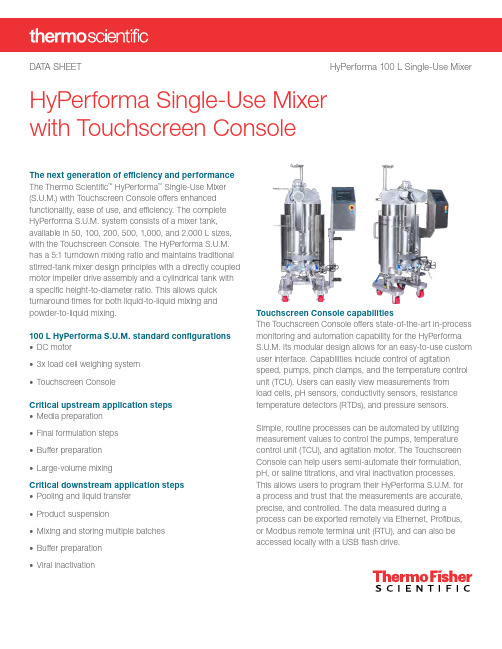
DATA SHEET HyPerforma 100 L Single-Use MixerHyPerforma Single-Use Mixer with Touchscreen ConsoleThe next generation of efficiency and performance The Thermo Scientific ™ HyPerforma ™ Single-Use Mixer (S.U.M.) with Touchscreen Console offers enhanced functionality, ease of use, and efficiency. The complete HyPerforma S.U.M. system consists of a mixer tank, available in 50, 100, 200, 500, 1,000, and 2,000 L sizes, with the Touchscreen Console. The HyPerforma S.U.M. has a 5:1 turndown mixing ratio and maintains traditional stirred-tank mixer design principles with a directly coupled motor impeller drive assembly and a cylindrical tank with a specific height-to-diameter ratio. This allows quick turnaround times for both liquid-to-liquid mixing and powder-to-liquid mixing.100 L HyPerforma S.U.M. standard configurations • DC motor• 3x load cell weighing system • Touchscreen ConsoleCritical upstream application steps • Media preparation • Final formulation steps • Buffer preparation • Large-volume mixingCritical downstream application steps • Pooling and liquid transfer • Product suspension• Mixing and storing multiple batches • Buffer preparation • Viral inactivationTouchscreen Console capabilitiesThe Touchscreen Console offers state-of-the-art in-process monitoring and automation capability for the HyPerforma S.U.M. Its modular design allows for an easy-to-use custom user interface. Capabilities include control of agitationspeed, pumps, pinch clamps, and the temperature control unit (TCU). Users can easily view measurements from load cells, pH sensors, conductivity sensors, resistance temperature detectors (RTDs), and pressure sensors. Simple, routine processes can be automated by utilizing measurement values to control the pumps, temperature control unit (TCU), and agitation motor. The Touchscreen Console can help users semi-automate their formulation, pH, or saline titrations, and viral inactivation processes. This allows users to program their HyPerforma S.U.M. for a process and trust that the measurements are accurate, precise, and controlled. The data measured during a process can be exported remotely via Ethernet, Profibus, or Modbus remote terminal unit (RTU), and can also be accessed locally with a USB flash drive.Note: Models without water jackets include the same features as the water-jacketed models shown here, but without the jacket and inlet/outlet ports. Optional load cells and cable management system are not shown. See the accessories section for more information about these items.HyPerforma S.U.M. design features and options 1. Powder hanger for 1 kg, 5 kg, and 25 kgThermo Scientific ™ Powdertainer ™ BioProcess Containers (BPCs)2. Mixing assembly with shield 3. Bearing port receiver with clamp 4. Mixer motor5. Shelves and basket (optional)6. Drive shaft, stored7. Liquid sight window8. Touchscreen Console9. Probe clip hangers 10. Probe access windows11. Cart assembly12. Standard tool set: 10 mm (3/8 in.) x 16.9 N-m(150 in.-lb.) square torque wrench; load cell and motor cap lockout wrench 13. 0.95 cm (3/8 in.) dimpled jacket 14. Stainless steel outer support container 15. Handles with cable management clips 16. Bottom cutouts/pins for BPC attachmentand alignment 17. Bleed valve (jacketed models only)18. 3.8 cm (1.5 in.) tri-clamp connection ports for waterinlet/outlet (jacketed models only)19. Casters (2 swiveling, 2 fixed)Front view Back view356891315101811912HyPerforma S.U.M. design specificationsHyPerforma S.U.M. DeltaV capability enhancement As an engineer-to-order product, the Thermo Scientific ™ HyPerforma ™ Single-Use Mixer (S.U.M.) with Touchscreen Console can be fully integrated with either Thermo Scientific ™ HyPerforma ™ G3 Bioprocess Controllers or controllers from other manufacturers—providing an open-architecture mixing solution configured to your uniquerequirements. The Touchscreen Console has the capability to integrate Thermo Scientific ™ TruBio ™ automation software powered by the DeltaV ™ Distributed Control Platform from Emerson, enabling users to optimize data acquisition while maintaining full compliance with 21 CFR Part 11.Top view217 cm (85.5 in.) Powdertainer BPC hanger height30 cm (11.8 in.)Electrical panel width57 cm (22.3 in.)Cart width92 cm (36.4 in.)Overall length58 cm (22.9 in.)Cart length43 cm (17.0 in.)Shelf width130 cm (51.1 in.)Overall width153 cm (60.2 in.) Motor height123 cm (48.4 in.) Tank height135 cm (53.1 in.) Touchscreen height 36 cm (14.1 in.) Tank bottom 19 cm (7.6 in.) Cart height 0 cm (0 in.)Front viewAccessoriesSensors and pinch valvesReusable pH and conductivity probes as well as single-use pressure sensors have been approved and qualified for use with the Touchscreen Console. pH and conductivity measurements can be used to control titration pumps, which enable automatic titration capabilities. Pressure sensors are used in the BPC or line sets to monitor the BPC or liquid pressure, respectively. The BPC can be filled with the proper amount of air when using the pressure sensor in the BPC. The liquid pressure module in the Touchscreen Console is used to control a transfer pump, based on the liquid pressure. Optional pneumatic pinch valves can be used on the fill and harvest lines. These valves automatically open and shut when using the fill and/or harvest modules in the Touchscreen Console.Ordering informationpH sensorThermo Fisher Scientific SV51147.02Mettler Toledo SV51147.01Broadley JamesSV51147.03Conductivity sensor JUMO SV51148.01Mettler Toledo SV51148.02Pressure sensor(single-use, included in BPC and/or fluid transfer assembly)PendoTECH 3/8 in. ID tubing SV20826.05PendoTECH 1/2 in. ID tubing SV20826.01Pinch valve, harvest line Thermo Fisher Scientific SV51108.08Pinch valve, fill line Thermo Fisher ScientificSV51108.05Probe clipsProbe clips are used to hold the probes in place on the S.U.M. tank. The independently movable probe clips hangon a thin brace above the probe port tank cutout.Heavy-duty tubing clampsHeavy-duty clamps are used to pinch off line sets that are not in use, to prevent process fluids from escaping. Prior to insertion of sterile probes, tubing clamps must be in place to close off probe ports.Load cellsLoad cells are typically radially mounted in sets of three. The mounting location varies slightly for each size in order to allow easy access to the bottom drain or spargingmechanisms and tubing.Ordering informationCat. No.Heavy-duty tubing clamp (single)SV20664.01Heavy-duty tubing clamp (10 pack)SV20664.04Ordering informationDescriptionCat. No.4 plastic probe clips SV50177P.01Cable management systemThe optional cable management system connects to the left side of the S.U.M. and is used to properly route tubing and cables along the side of the S.U.M.Powdertainer armA Powdertainer arm is available as an option forpowder-to-liquid applications. It holds the container of powder above the mixer and attaches it to the BPC with a clamp. The arm adjusts vertically and swivels to enable convenient lifting of the Powdertainer BPC onto the hanger.Powdertainer armPowdertainer hookPowdertainer-to-BPCport clampTank attachmentHandleProbeThreaded probe attachmentMoldedbellows cover Autoclave tray and probe assemblyThe autoclave tray holds the electrochemical probes and bellows in place during the autoclave sterilization process. Design elements include the following:• Fabricated from stainless steel• Plastic handle provides for easy transport right out of the autoclave• Positions probes on 15% incline for greater probe and membrane longevity• Prevents probe bellows from collapsing during sterilization• Probe holder accommodates two probesOrdering informationDescriptionCat. No.Autoclave tray (stainless steel with plastic carrying handle)SV50177.01Ordering informationDescriptionCat. No.Cable management system (50 L, 100 L)SV50992.01Ordering informationDescriptionCat. No.Powdertainer arm (50 L–1,000 L)SV51002.01Standard 100 L S.U.M. hardwareStandard 100 L S.U.M. hardware (cont.)Standard 100 L BPC for powder-to-liquid applications without probe portsEnd treatment1Addition line12.7 mm (1/2 in.) x 19.1 mm (3/4 in.) C-Flex x 122 cm (48 in.)Plugged 12.7 mm (1/2 in.) MPX insert 2Recirculation/sample line 12.7 mm (1/2 in.) x 19.1 mm (3/4 in.) C-Flex x 137 cm (54 in.) splits to 12.7 mm (1/2 in.) x 19.1 mm (3/4 in.) C-Flex x 61 cm (24 in.) and 12.7 mm (1/2 in.) x 19.1 mm (3/4 in.) C-Flex x 30 cm (12 in.)Capped 12.7 mm (1/2 in.) MPX insert Plugged 12.7 mm (1/2 in.) MPX body 3Powder addition port 76 mm (3 in.) sanitary fitting, tri-clampCap with gasket4Bottom drain12.7 mm (1/2 in.) x 19.1 mm (3/4 in.) C-Flex x 122 cm (48 in.)Capped 12.7 mm (1/2 in.) MPX bodyHyPerforma S.U.M. BPCsOpen-top or closed-top Thermo Scientific ™ BPC designs are available with Thermo Scientific ™ CX5-14 and Aegis ™ 5-14 film options.Back faceStandard 100 L BPC for liquid-to-liquid applications without probe portsDescriptionTubing set (inner diameter x outer diameter x length)End treatment1Bottom drain 12.7 mm (1/2 in.) x 19.1 mm (3/4 in.) C-Flex x 122 cm (48 in.) Capped 12.7 mm (1/2 in.) MPX body 2Fill line 12.7 mm (1/2 in.) x 19.1 mm (3/4 in.) C-Flex x 122 cm (48 in.) 38.1 mm (1 1/2 in.) tri-clamp (SterilEnz ™)3Vent filter 6.4 mm (1/4 in.) x 12.7 mm (1/2 in.) C-Flex x 10.2 cm (4 in.)Sterile hydrophobic vent filter (0.2 μm PVDF, Acro ™ 50)4Recirculation/sample line 12.7 mm (1/2 in.) x 19.1 mm (3/4 in.) C-Flex x 137 cm (54 in.) splits to 12.7 mm (1/2 in.) x 19.1 mm (3/4 in.) C-Flex x 61 cm (24 in.) and 12.7 mm (1/2 in.) x 19.1 mm (3/4 in.) C-Flex x 30 cm (12 in.)Capped 12.7 mm (1/2 in.) MPX insert Plugged 12.7 mm (1/2 in.) MPX body 5Addition line9.5 mm (3/8 in.) x 15.9 mm (3/4 in.) C-Flex x 61 cm (24 in.)Plugged 9.5 mm (3/8 in.) MPX insertFront faceStandard 100 L BPC for powder-to-liquid applications with probe portsTubing set (inner diameter x outer diameter x length)End treatment1Recirculation line 12.7 mm (1/2 in.) x 19.1 mm (3/4 in.) C-Flex x 137 cm (54 in.) splits to12.7 mm (1/2 in.) x 19.1 mm (3/4 in.) C-Flex x 61 cm (24 in.) and12.7 mm (1/2 in.) x 19.1 mm (3/4 in.) C-Flex x 30 cm (12 in.)Capped 12.7 mm (1/2 in.) MPX insertPlugged 12.7 mm (1/2 in.) MPX body2Addition line12.7 mm (1/2 in.) x 19.1 mm (3/4 in.) C-Flex x 122 cm (48 in.)Plugged 9.5 mm (3/8 in.) MPX insert3–4Probe ports (2)None Kleenpak™ aseptic connector KPCHT series (female)5Thermowell/small-volumesample lineThermowell adapter for 3.2 mm (1⁄8 in.) x6.4 mm (1/4 in.) C-Flex x 30 cm (12 in.)Luer and SmartSite™ valve port6Bottom drain12.7 mm (1/2 in.) x 19.1 mm (3/4 in.) C-Flex x 122 cm (48 in.)Capped 12.7 mm (1/2 in.) MPX body7Powderaddition port76 mm (3 in.) sanitary fitting, tri-clamp Cap with gasket Front faceBack faceBottom drainStandard open-top linerDescriptionCat. No.100 L standard open-top liner, 0 probes, CX3-9 film SH30762.06Standard impeller sleeveDescriptionCat. No.100 L impeller sleeve for open-top mixing*SH30749.14* The bearing hub needed for open-top mixing is automatically supplied with the tank hardware.Standard 100 L BPC for liquid-to-liquid applications with probe portsLine DescriptionTubing set (inner diameter x outer diameter x length)End treatment1–2Probe ports (2)NoneKleenpak aseptic connector KPCHT series (female)3Thermowell/ small-volume sample line Thermowell adapter for 3.2 mm (1⁄8 in.) x 6.4 cm (1⁄4 in.) C-Flex x 30 cm (12 in.)Luer and SmartSite valve port 4Recirculation line 12.7 mm (1/2 in.) x 19.1 mm (3/4 in.) C-Flex x 137 cm (54 in.) splits to 12.7 mm (1/2 in.) x 19.1 mm (3/4 in.) C-Flex x 61 cm (24 in.) and 12.7 mm (1/2 in.) x 19.1 mm (3/4 in.) C-Flex x 30 cm (12 in.)Capped 12.7 mm (1/2 in.) MPX insert Plugged 12.7 mm (1/2 in.) MPX body 5Fill line 12.7 mm (1/2 in.) x 19.1 mm (3/4 in.) C-Flex x 122 cm (48 in.)38.1 mm (1 1/2 in.) tri-clamp (SterilEnz)6Vent filter 6.4 mm (1⁄4 in.) x 12.7 mm (1⁄2 in.) C-Flex x 10.2 cm (4 in.)Sterile hydrophobic vent filter (0.2 μm PVDF, Acro 50)7Addition line 12.7 mm (1/2 in.) x 19.1 mm (3/4 in.) C-Flex x 122 cm (48 in.)Plugged 9.5 mm (3/8 in.) MPX insert 8Bottom drain12.7 mm (1/2 in.) x 19.1 mm (3/4 in.) C-Flex x 122 cm (48 in.)Capped 12.7 mm (1/2 in.) MPX bodyCustom BPC productsNote: Not all options are available for all ports. It is not possible to customize port type, port location, chamber dimensions, or mixing assembly.For additional information, please see the selection guides in the product catalog.11Find out more at /sumFor Research Use or Further Manufacturing. Not for diagnostic use or direct administration into humans or animals.© 2021 Thermo Fisher Scientific Inc. All rights reserved. All trademarks are the property of Thermo Fisher Scientific and its subsidiaries unless otherwise specified. Allen Bradley is a trademark of Allen-Bradley Company. Applisens is a trademark of Applikon B.V. Corporation. BioQuate is a trademark of General Electric Company. Broadley James is a trademark of Broadley-James Corporation. Clave is a trademark of ICU Medical, Inc. Colder Products Company and CPC are trademarks of Colder Products Company. DeltaV is a trademark of Emerson. Gore is a trademark of W. L. Gore & Associates. Kleenpak and Acro are trademarks of Pall Corporation. Lynx is a trademark of Merck KGaA. Mettler Toledo is a trademark of Mettler-Toledo AG. PreSense is a trademark of PreSens Precision Sensing GmbH. PharMed, PharmaPure, and C-Flex are trademarks of Saint-Gobain Performance Plastics Corporation. PendoTECH is a trademark of PendoTECH. SmartSite is a trademark of Carefusion 303, Inc. SterilEnz is a trademark of PAW BioScience Products, Inc. COL014582 0221Models without water jackets may have slightly different dimensions than the water-jacketed model shown in this data sheet. See the drawings provided with your unit for exact dimensions for non-jacketed models. Non-jacketed models do not have the capability to heat or cool the liquid inside the tank.12Ordering information Non-jacketed, DC motor, Touchscreen Console, with load cells SUM0100.9001Jacketed, DC motor, Touchscreen Console, with load cellsSUM0100.9002Standard powder-to-liquid BPC100 L 0CX5-14SH31046.01100 L 0Aegis 5-14SH31052.01Standard liquid-to-liquid BPC100 L 0CX5-14SH31046.03100 L 0Aegis 5-14SH31052.03Standard powder-to-liquid BPC *100 L3CX5-14SH31046.02100 L 3Aegis 5-14SH31052.02Standard liquid-to-liquid BPC *100 L 3CX5-14SH31046.04100 L3Aegis 5-14SH31052.04* All 100 L BPCs with probe ports are designed to allow probes to work properly at 5:1 turndown levels. These BPCs are only compatible with the HyPerforma hardware shown in this document. If you are using an older version of the S.U.M. hardware, do not use these items; instead refer to the legacy S.U.M. user manual or data sheets.。
赛默飞世尔-七易测量-标准操作程序-电导率测量说明书
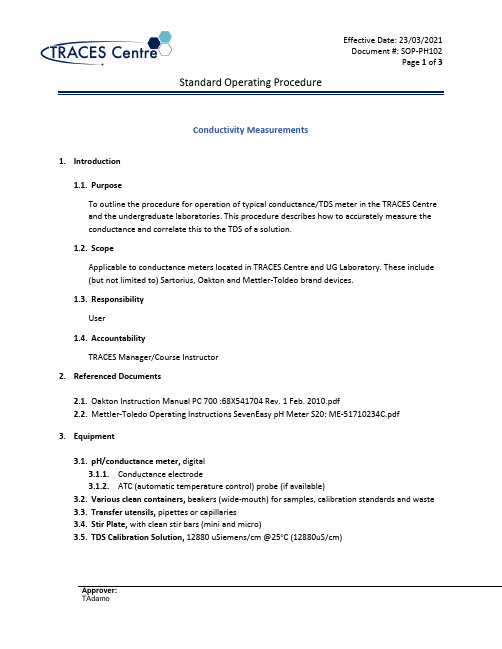
Conductivity Measurements1.Introduction1.1.PurposeTo outline the procedure for operation of typical conductance/TDS meter in the TRACES Centre and the undergraduate laboratories. This procedure describes how to accurately measure the conductance and correlate this to the TDS of a solution.1.2.ScopeApplicable to conductance meters located in TRACES Centre and UG Laboratory. These include (but not limited to) Sartorius, Oakton and Mettler-Toldeo brand devices.1.3.ResponsibilityUser1.4.AccountabilityTRACES Manager/Course Instructor2.Referenced Documents2.1.Oakton Instruction Manual PC 700 :68X541704 Rev. 1 Feb. 2010.pdf2.2.Mettler-Toledo Operating Instructions SevenEasy pH Meter S20: ME-51710234C.pdf3.Equipment3.1.pH/conductance meter, digital3.1.1.Conductance electrode3.1.2.ATC (automatic temperature control) probe(if available)3.2.Various clean containers, beakers (wide-mouth) for samples, calibration standards and waste3.3.Transfer utensils, pipettes or capillaries3.4.Stir Plate, with clean stir bars (mini and micro)3.5.TDS Calibration Solution, 12880 uSiemens/cm @25o C (12880uS/cm)4.Procedures4.1.Conductance Electrode: The protective probe guard can be removed temporarily for cleaning;it must be re-attached during measurement and calibration. Erroneous results will occur while the probe guard is removed. Always immerse the probe beyond upper steel band for bestresults. Use the fill line on the outside of the probe guard for reference.4.2.Conductance Calibration: For best results, periodic calibration with known TDS Calibrationstandards recommended. Various units are capable of automatic or manual calibration forconductivity (check with the owner’s manual/TRACES Staff). This SOP will discuss manualcalibration. Many conductivity meter are also equipped to handle single point and/or multi-point calibration. The TDS and conductivity range, discussed below, can be set automatically or manually.4.2.1.Manual Conductivity & TDS Calibration4.2.1.1.Rinse or immerse the probe before calibration and between samples withdeionized water.4.2.1.2.Low conductivity standard solutions (less than 20 μS) are unstable and arevery temperature dependent. As a result, reproducible calibration results arechallenging in lowest measurement range #1 (0.00 to 20.0 μS).4.2.1.2.1.Place 35-40mL of Conductivity Calibration solution into separate 50mLbeaker with a magnetic stir bar. Provide stirring for best results.4.2.1.2.2.Press ‘MODE’ as needed to select conductivity (μS or mS) or TDS (ppmor ppt) calibration.4.2.1.2.3.Dip the electrode into the calibration standard and press ‘CAL/MEAS’.4.2.1.2.4.The primary display will show the current reading, while the secondarydisplay will be the factory default value. Adjust the conductivity or TDS readingusing ‘arrow up’ or ‘arrow down’ to match the uS/cm value written on thecalibration bottle. Press ‘ENTER/RANGE’ to accept. The primary reading willflash briefly before returning to measurement mode upon successfulcalibration.4.2.1.2.5.STIR BAR MUST NOT MAKE CONTACT WITH THE ELECTRODE4.3.Conductance and TDS Measurements:4.3.1.Sample Measurement Procedure4.3.1.1.Rinse the electrode with de-ionized water before use to remove any impurities.Gently shake excess water droplets.4.3.1.2.Dip the probe into the sample beyond the upper steel band (utilize the fill lineon the outside of the probe guard for reference).4.3.1.3. Allow time for the reading to stabilize. Note the reading on the display. Theclear yellow protective probe guard must be attached during measurement. Erroneous results will occur while the probe guard is removed. 4.3.1.4.The conductivity meter will select the optimal range automatically by default.Refer to TABLE 1 for the list of available ranges. 4.3.1.5. For manual ranging, press ‘ENTER/RANGE’. MEAS will flash, indicating thatmanual ranging is active. To select the next range press ‘ENTER/RANGE’ again. Select the range that best meets your needs. The reading should show the greatest number of digits in any given run. 4.3.1.6. Press ‘ENTER/RANGE’ 5x, automatic ranging is resumed.5. Cleaning up5.1. Once you have completed the use of the pH meter, ensure you have properly cleaned theelectrodes by rinsing with deionized water. Place the electrode in pH4 solution.5.2. If instructed, place the pH electrode in the pH storage solution provided by the technical staff.。
RevcoTM RDE 系列、 FormaTM FDE 系列、 HERAfreezeTM HDE 系

超低温降温仪 Revco TM RDE 系列、Forma TM FDE 系列、HERAfreeze TM HDE 系列和 Thermo Scientific TM TDE 系列安装和操作329712H61 •修订版 F • 2022 年 3 月重要请阅读本说明手册。
不按照本手册中的说明操作可能会导致设备损坏、操作人员受伤和设备性能低下。
小心所有内部调整和维护均必须由合格的检修人员执行。
本手册中的材料仅供参考。
其中的内容和产品可能发生更改,恕不另行通知。
赛默飞世尔科技不提供任何关于本手册的声明或担保。
在任何情况下,Thermo 对因使用本手册或与使用本手册相关的直接或间接损坏不负任何责任。
© 2022 Thermo Fisher Scientific Inc. 保留所有权利。
目录型号 (1)安全注意事项 (2)开箱 (3)装箱单 (3)一般性建议 (4)温度监测 (4)一般用法 (4)初次装载 (4)电池舱门打开/关闭 (4)运行标准 (5)电气规格 (5)安装 (6)位置 (6)保护导体电流 (6)调平 (6)刮冰刀 (6)备份系统(可选) (7)超级绝缘机柜结构 (7)门操作 (7)压力均衡口 (7)安装远程警报连接器 (7)预期用途 (8)操作 (9)初始启动 (9)操作概述 (9)显示 (9)设置 (10)关机 (10)刮冰刀说明 (11)预期用途 (11)非预期用途 (11)注意事项和使用方法 (11)备份系统(可选) (12)CO2和 LN2注意事项 (12)安装 (12)启动 (13)操作 (13)温度记录仪(可选) (14)设置和操作 (14)更换记录纸 (14)校准调整 (14)维护 (15)清洁冷凝器 (15)清洁冷凝器过滤器 (15)垫圈维护 (15)为降温仪除霜 (15)电池维护 (15)维护计划 (16)故障排除指南 (17)错误代码 (20)保修 (21)保修(国际) (22)附录 A:警报摘要 (23)附录 B:Modbus ASCII 参数表 (25)WEEE 合规 (34)联系信息 (35)型号表 1. 适用的型号Forma - FDExxx86F*300/400/500/600A/D/VForma - FDExxx86F* - ULTS 300/400/500/600A/D/VThermo Scientific –TDExxx86F*300/400/500/600A/D/VThermo Scientific –TDExxx86F*- ULTS300/400/500/600A/D/VHERAfreeze – HDExxx86F*300/400/500/600A/D/VRevco - RDExxx86F*300/400/500/600A/D/V1|型号Thermo Fisher Scientific 超低温降温仪安全注意事项在本手册中,使用下列符号和惯例:下面列举了一些适用于本产品的重要安全防范措施:EMC(适用时)此设备的 EMC 注册仅限商业用途。
赛默飞世尔科技应用说明书_630_活性成分

IntroductionFourier transform infrared (FTIR) spectroscopy is commonly used in the pharmaceutical industry for the identification of drug products, asspecified in the US, European, Japanese, Chinese, Indian and International Pharmacopoeias. Like all optical spectroscopic techniques, FTIR can also provide quantitative information and can be used to predict the concentration of pharmaceuticals in both solid and liquid states. FTIR follows the Beer-Lambert law, thus the absorbance of a sample is directly proportional to the concentration, the pathlength and the molar absorptivity. Since the molar absorptivity of a molecule is constant and the measurement pathlength can be controlled, the absorbance of a sample is directly proportional to the concentration.In FTIR spectroscopy, sample preparation and sampling methodology often defines the success of the measurement. For solid samples, the classic transmission measurement technique involves dispersing the sample in potassium bromide powder (KBr) and then placing the salt mixture under pressure to form a transparent pellet. In addition to the difficulties associated with making acceptable KBr pellets, variance in mixing and theQuantitative measurement of active pharmaceutical ingredients using the diffuse reflectance Cary 630 FTIRApplication noteAuthorsFrank Higgins and John Seelenbinder Agilent Technologies Danbury, CT, USAPharmaceuticalsdimensions of the resulting pellet make this technique less useful for quantitative measurement, though itis still used for qualitatively ascertaining the identityof a compound. For ease of use, analytical accuracy and speed of measurement, analysts have turnedto other FTIR sampling methodologies for analysisof pharmaceutical compounds that are solids — notably attenuated total reflectance (ATR) and diffuse reflectance infrared Fourier transform (DRIFT).This application note will demonstrate the effectiveness of the DRIFT method for the quantitative measurement of a powdered sample using the Agilent Cary 630 FTIR system. Mixtures of acetaminophen in corn starch are used to demonstrate the analysis of the active pharmaceutical ingredient (API) in the presence of an excipient.Analysis of pharmaceutical compounds using the Cary 630 FTIRThe Cary 630 FTIR spectrometer is ultracompact, robust, easy to use, and possesses class-leading performance. With its optimized sampling technology, the Cary 630 is an exceedingly useful spectrometer for QA/QC, analytical services and method development in the pharmaceutical industry. The Cary 630 is well matched to these applications due to its interchangeable sample interfaces that allow easy switching between ATR for qualitative sample identification, and diffuse reflectance for quantitative analysis. Additionally, the Cary 630 is available with Agilent’s exclusive DialPath technology, which makes quantitative and qualitative analysis of liquid samples equally quick and easy. With CFR 21 part 11 compliant software and automated IQ/OQ capability, the Cary 630 is well suited to pharmaceutical analysis. For qualitative analysis, the Cary 630 ATR sampling technology is particularly useful as a replacement for the KBr pellet transmission method, since it allows quick measurement of neat solids without any sample preparation. The system employs a diamond ATR element that eliminates scratching of the window and is highly resistant to damage by chemicals. The innovative sample press ensures proper contact of the sample with the diamond ATR for best spectral results, while at the same time eliminates the possibility of overpressure on the ATR crystal. Since ATR measures infrared absorbance via an evanescent wave that penetrates just a few microns, the sample pathlength is quite short. This makes ATR quite useful for qualitative analysis of solids, but less useful for quantitative analysis of solids. For quantitative analysis of powdered or coarse grained solids, DRIFT is ideal, since it provides both easy sample preparation and quantitative precision. With the DRIFT technique, diffusely reflected light interacts with sample particles several times before being collected by the instrument collection optics. These multiple interactions give the DRIFT technique a larger sampling volume, decreasing issues associated with heterogeneous mixtures. In some cases, strongly absorbing samples are diluted in KBr before analysis, but the powdered mixture is simply placed into a sample cup eliminating the preparation difficulties associated with the classic transmission pellet-making technique. Experimental conditionsFive calibration samples ranging from 0 to 10% acetaminophen in corn starch were prepared. These samples were split into two lots. One lot was diluted in dry KBr in a ratio of 1:10 (sample:KBr) before analysis, whereas the second set was measured neat, without any sample preparation. All measurements were carried out on an Agilent Cary 630 FTIR incorporating a diffuse reflectance sample interface. Data was recorded with a 30 second collection time (74 scans) at 4 cm-1 resolution. The Cary 630 MicroLab PC software was used for data collection, and calibrations were developed using Agilent Resolutions Pro software. Results and discussionComparison of DRIFT measurements in diluted and undiluted samplesDiffuse reflectance measurement of powdered samples typically results in a relatively long pathlength. Figure 1 shows a pictorial representation of the light path at the sample. It shows that several paths are possible, increasing the interaction of the infrared light with the sample. The long pathlength resulting from these multiple interactions often causes concentrated samples to have absorbance values beyond the dynamicrange of an instrument. Additionally, strong absorbances reduce the amount of light returning to the instrument detector, which results in higher noise.Quantitative measurement using diffuse reflectance — diluted samplesDilution of the 5 calibration standards produced optimized absorbance values between 0.6–0.8absorbance units for the strongest band as is shown in Figure 3; the calibration curve is shown inFigure 4. The 1559 cm -1 acetaminophen band is used for this calibration, and is ratioed to a reference frequency at 1379 cm -1 (resulting from corn starch). Acetaminophen has minimal absorbance at 1379 cm -1; this frequency can therefore be used as an internal standard to correct for any pathlength differencecaused by particle size variation. The calibration showsexcellent linearity and a correlation coefficient of 0.999.Powder Sample cupFigure 1. Pictorial diagram of diffuse reflectance sample measurement of apowdered sampleName Acetaminophen (wt. %)CS10CS20.7643CS3 2.2519CS4 4.8985CS59.7337Figure 3. Carbonyl region of the FTIR diffuse reflectance calibration spectra of acetaminophen in cornstarch measured after dilution in KBr powderFigure 4. Calibration plot of the acetaminophen peak height at 1559 cm -1 ratioed to the 1379 cm -1 peak height absorbance. The samples are diluted10:1 in KBr prior to measurement.In order to reduce the overall absorbance, samples are often mixed with a non-absorbing, diffusely reflecting salt such as KBr. The salt reduces the concentration of the sample allowing the absorbance values to fall within the linear range. To demonstrate this effect, a sample of acetaminophen in corn starch was measured with and without dilution in dry KBr. Figure 2 shows the measured spectra of the sample with (red) and without (blue) dilution. In the undiluted sample, the absorbance of both the OH stretch near 3400 cm -1 and the COstretch near 1100 cm -1 are above 2.0 absorbance units, resulting in a large amount of noise on the strongly absorbing bands.Figure 2. DRIFT measurement of neat (blue) and diluted (red) acetaminophen in corn starchIt should be noted in the above example, that the noise present is on bands associated with the corn starch excipient. The lower intensity bands arising from the acetaminophen are not affected. The most prominent absorbance bands of the acetaminophen at 1559 cm -1 and 1513 cm -1 are still within their linear range.Name Acetaminophen (wt. %)CS10CS20.7643CS3 2.2519CS4 4.8985CS59.7337Quantitative measurement using diffuse reflectance — neat samplesThe 5 calibration standards were measured without dilution in KBr powder, and the spectra of thecalibration set are shown in Figure 5. A quantitative calibration was made by correlating the ratio of the same acetaminophen band area centered at 1559 cm -1, to the corn starch CO overtone near 2100 cm -1. This overtone band was chosen since the 1379 cm -1 band that was used for the diluted samples was clearly too absorbing. The calibration plot is shown in Figure 6; a perfect correlation coefficient of 1.000 was found for this calibration.are commonly used in classic transmission FTIRspectroscopy. In this case, the neat samples produced a calibration which was as accurate as that of the diluted samples. This is due to the fact that the bands of the neat active ingredient remained in the linear absorbance range, while those of the excipient were too absorbing for accurate analysis. In some cases, where both active and excipient bands are too absorbing and thus non-linear, simple dilution in powdered KBr is all that is necessary to get accurate quantitative measurements. The interchangeable, easy-to-use sampling technologies available for the Agilent Cary 630 FTIR are ideal for quantitative and qualitative analysis in the pharmaceutical industry — DRIFT for quantitative analysis of solids; ATR for qualitative identification of solids; DialPath for quantitative and qualitative analysis of liquid samples.Figure 5. Carbonyl region of the FTIR diffuse reflectance calibration spectra of acetaminophen in cornstarch measured neat without dilutionConclusionsDiffuse reflectance is shown to be an excellent technique for the quantitative analysis ofpharmaceutical solids and powders, eliminating the need to prepare pressed KBr pellets, which/chemAgilent shall not be liable for errors contained herein or for incidental or consequential damages in connection with the furnishing, performance or use of this rmation, descriptions, and specifications in this publication are subject to change without notice.© Agilent Technologies, Inc. 2011Published November 29, 2011 Publication number: 5990-9414ENFigure 6. Calibration plot of the acetaminophen peak area absorbance at 1600–1500 cm -1 ratioed to the area near 2100 cm -1. The samples were measured neat by diffuse reflectance FTIR.。
赛默飞世尔Thermo Heraeus UT 6200 烘箱

file:///D|/bihecpdf/赛默飞世尔Thermo Heraeus UT 6200 烘箱烘箱、干燥箱.htm[2010-1-9 1:15:49]
at 150°C 3±°C at 300°C 6±°C 温度精度 ≤0.5±°C 电源要求 额定电压(50/60Hz) 230~(V) 额定功率 2.8kW 热输出 1570(Wh/h) 1)温控范围:T型:室温+10°C~300°C;UT型:室温+20°C~300°C 2)在风机关闭,烘箱内无样品的情况下测试,符合DIN12880,Part 2标准。 3)其他电压,根据要求。
赛默飞世尔Thermo Heraeus UT 6200 仪器标签
Heraeus 6000 系列烘箱采用模块化设计。
采用一系列措施确保操作安全,如防倾斜的隔板。
高效绝热设计,确保较低的表面温度,节省运行费用。
如需在高载荷下仍保持精确温度和快速加热,请选择采用强制对流循环方式的UT系列烘箱。
© 2005-2009 必和国际贸易(香港)有限公司 版权所有,并保留所有权利。 上海市长乐路989号2006室,邮编:200031,电话:021-60896520,13661956095,, info@
file:///D|/bihecpdf/赛默飞世尔Thermo Heraeus UT 6200 烘箱烘箱、干燥箱.htm[2010-1-9 1:15:49]
主要特点: 强制对流循环方式
模块式设计,尺寸选择范围广。
选配件灵活多样。
能在极短时间内升温到300度,热量输出很少,节省能量。
高质量原材料
ISO生产体系认证
德国制造,性能可靠
技术参数: 标准型号 UT 6200 尺寸(w x h x d) 外形尺寸 895/816/715(mm) 35.2/35.1/28.1(inch) 高度 24(mm) 0.9(inch) 内部尺寸 总箱体积 180(L) 内部尺寸 (w x h x d) 554/644/503(mm) 21.8/25.4/19.8(inch) 搁板 标准/最多 2/18(NO.) 空箱体积重量 100(kg) 220(Ibs.) 温度 控温范围 温度均一性 at 70°C 1±°C
赛默飞世尔ITQ系列GC-MS样本

四极式离子阱 GC/MS nITQ™ 系列为真实世界的样品分析而优化设计●最可靠的离子阱技术●无可匹敌的全扫描灵敏度●先进的MSn扫描对复杂基质样品提供高的选择性●外离子源能够得到最大的生产率、可靠性,以及经典的谱库检索质谱图Thermo Scienti fic ITQ 系列外源离子阱质谱仪是得到工业界认可的传统离子阱仪器中最新的一代—GC/MS n 。
能提供无与伦比的分析结果,可承受满负荷的全天工作 — 无论是监测工业企业生产设备附近水质量的环境实验室,还是为调查犯罪做线索追踪的国家法院实验室,或者是为全球性经济力争保护食品的食品安全实验室,ITQ 系列都能满足您的分析需要。
Thermo Scienti fic ITQ 系列四极式离子阱当前最高灵敏度的离子阱质谱仪ITQ 系列GC/MS n 仪器给你的实验室提供选择的机会,它允许你根据你实验室的需求选择相匹配的GC/MS 系统。
• Thermo Scienti fic ITQ 700™: 常规实验室的理想选择,它适合于空间和预算都有限的实验室做GC/MS 全扫描分析。
• Thermo Scienti fic ITQ 900™:灵活进样口和检测器的选择,进一步扩大了GC 的灵活性。
• Thermo Scienti fic ITQ 1100™: 从研究到常规应用的最终选择,它具有强大的新工具程序,能够扩展你实验室的能力。
ITQ 系列以提高性能的理念而设计,通过不断适应随着时间的推移而逐渐改变的工作流程和需要,来节省您的投资。
如果你需要改变,升级你的仪器可获得更新的性能、更高灵活度和更强大的功能。
更好的是,无论如何选择, 你都会得到可用的灵敏性最好的GC-离子阱质谱仪,即使复杂的基质,也会获得很低的检出限。
ITQ 系列提供了一系列的操作模式, 从全扫描MS 和MS/MS (MS n ),到正/负化学离子化。
连续全扫描和MS/MS 的双模式或者正离子/负离子化学离子源(PPINICI ™)*允许我们单次进样获得两种形式的数据。
哈克流变仪转子对应粘度范围

哈克流变仪转子对应粘度范围哈克流变仪是一种用于测量物质粘度的仪器,通过使用旋转的转子在物质中施加剪切力,并测量物质对这种剪切力的响应来确定粘度。
不同的转子设计和尺寸可以适用于不同范围的粘度测量。
以下是一些常见的哈克流变仪转子及其对应的粘度范围:1.Rotor1,也称为6°cone/plateconerotor:适用于粘度范围为0.5mPa·s至1,000mPa·s的样品测量。
这种转子适用于低粘度液体,如溶液、胶体等。
2.Rotor2,也称为30°cone/plateconerotor:适用于粘度范围为5mPa·s至2,000mPa·s的样品测量。
这种转子适用于中等粘度液体的测量,如墨水、油漆、胶水等。
3.Rotor3,也称为4元血浆和血球牛奶盘型转子:适用于粘度范围为200mPa·s至5,000mPa·s的样品测量。
这种转子适用于高粘度液体的测量,如乳液、凝胶等。
4.Rotor4,也称为60°cone/plateconerotor:适用于粘度范围为2,000mPa·s至80,000mPa·s的样品测量。
这种转子适用于非常高粘度液体的测量,如浆糊、糖浆等。
需要说明的是,不同型号的哈克流变仪可能具有不同的转子选项,每个转子的粘度范围也可能有所不同。
因此,在选择哈克流变仪转子时,应该根据具体的实验需求和样品的粘度范围来进行选择。
此外,哈克流变仪的转子设计和测量范围还与仪器的转速范围、温度控制系统等因素有关。
在使用哈克流变仪进行粘度测量时,应根据具体的使用说明和仪器参数来选择合适的转子和设定相应的测量条件,以确保准确可靠地进行粘度测量。
赛默飞(thermofisher)iCAP Qc ICP-MS电感耦合等离子体质谱技术参数
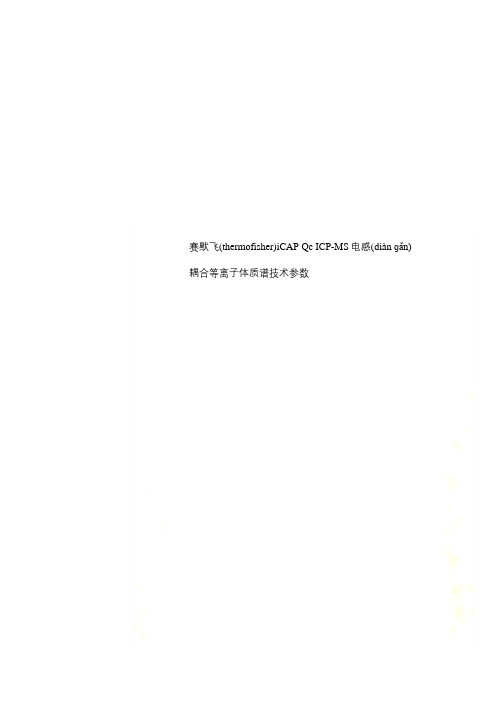
赛默飞(thermofisher)iCAP Qc ICP-MS电感(diàn ɡǎn)耦合等离子体质谱技术参数赛默飞(thermofisher)iCAP Qc ICP-MS电感(diàn ɡǎn)耦合等离子体质谱技术(jìshù)参数(cānshù)品牌(pǐn pái):赛默飞(thermofisher) 价格(jiàgé):140万型号iCAP Qc 技术规格1.仪器应用要求1.1.本仪器要求能适用于应用领域广泛的各种样品的元素分析、同位素分析和元素形态分析任务,满足环保、食品、地质、金属、生物样品、化工材料分析等等。
2.仪器工作环境2.1工作环境温度: 15-30℃.2.2工作环境湿度: < 80% (无冷凝)2.3电源:单相200-240V ,50 Hz3. 仪器规格要求:3.1 仪器硬件;3.1.1 雾化器:高效率石英同心雾化器,提供最佳的雾化效率。
*3.1.2 雾化室:小体积旋流型雾化室,死体积小,低记忆效应, 带半导体制冷装置,对雾化室制冷控温范围-10~20℃,用于精确控制雾化室温度,消除由于实验室条件的波动所引起的任何漂移,并提升仪器长期的稳定性。
*3.1.3 等离子体可视系统:具有Plasma TV功能,可以实时监控等离子体状态。
*3.1.4 可拆卸式石英炬管,石英中心管,采用卡式设计的炬管座,方便更换而无需拆卸气路。
*3.1.5 接口:拥有两种不同类型的接口技术,接口采用耐高盐设计,截取锥口径范围0.5~0.75mm,保证长期分析高盐样品的稳定性,满足高通量分析与大进样量的要求。
3.1.6 仪器主机ICP部分,配置质量流量计:包括等离子体气,辅助气,雾化气3路质量流量计。
*3.1.7 离子源:自激式全固态RF发生器,频率(pínlǜ)为27.12 MHz,采用变频(bi àn pín)技术快速匹配,适用乙腈等有机试剂直接进样。
赛默飞仪表需要设置的参数
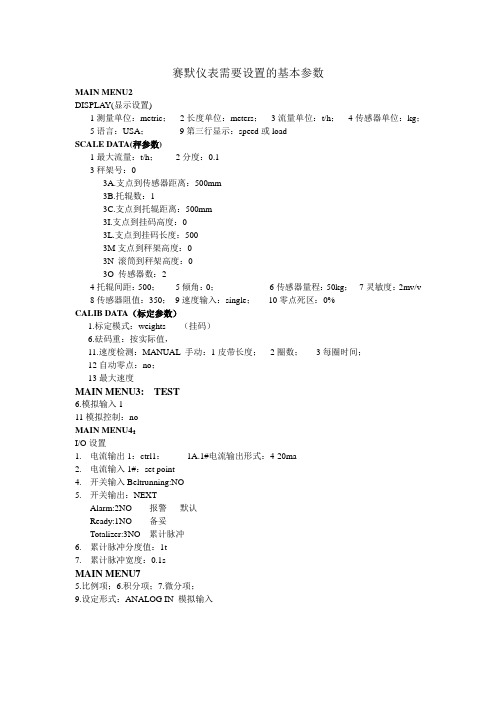
赛默仪表需要设置的基本参数MAIN MENU2DISPLAY(显示设置)1测量单位:metric;2长度单位:meters;3流量单位:t/h;4传感器单位:kg;5语言:USA;9第三行显示:speed或loadSCALE DATA(秤参数)1最大流量:t/h;2分度:0.13秤架号:03A.支点到传感器距离:500mm3B.托辊数:13C.支点到托辊距离:500mm3I.支点到挂码高度:03L.支点到挂码长度:5003M支点到秤架高度:03N 滚筒到秤架高度:03O 传感器数:24托辊间距:500;5倾角:0;6传感器量程:50kg;7灵敏度:2mv/v 8传感器阻值:350;9速度输入:single;10零点死区:0%CALIB DATA(标定参数)1.标定模式:weights (挂码)6.砝码重:按实际值,11.速度检测:MANUAL 手动:1皮带长度;2圈数;3每圈时间;12自动零点:no;13最大速度MAIN MENU3: TEST6.模拟输入111模拟控制:noMAIN MENU4:I/O设置1.电流输出1:ctrl1:1A.1#电流输出形式:4-20ma2.电流输入1#:set point4.开关输入Beltrunning:NO5.开关输出:NEXTAlarm:2NO 报警默认Ready:1NO 备妥Totalizer:3NO 累计脉冲6.累计脉冲分度值:1t7.累计脉冲宽度:0.1sMAIN MENU75.比例项;6.积分项;7.微分项;9.设定形式:ANALOG IN 模拟输入。
Haemophilus parainfluenzae HpaII 修 Plot 信息说明书

PRODUCT INFORMATIONHpa II#ER05111000 ULot: ___Expiry Date: _5'...C ↓C G G …3' 3'...G G C ↑C ...5'Concentration: 10 U/µLSource:Haemophilus parainfluenzae Supplied with: 1 mL of 10X Buffer TangoStore at -20°CIn total 2 vials. BSA included/onebioRECOMMENDATIONS1X Thermo Scientific Tango Buffer (for 100% HpaII digestion)33 mM Tris-acetate (pH 7.9), 10 mM magnesium acetate, 66 mM potassium acetate, 0.1 mg/mL BSA. Incubation temperature 37°C.Unit DefinitionOne unit is defined as the amount of HpaII required to digest 1 µg of lambda DNA in 1 hour at 37°C in 50 µL of recommended reaction buffer. DilutionDilute with Dilution Buffer (#B19): 10 mM Tris-HCl(pH 7.4 at 25°C), 100 mM KCl, 1 mM EDTA, 1 mM DTT, 0.2 mg/mL BSA and 50% glycerol. Double DigestsTango ™Buffer provided simplifies buffer selection for double digests. 98% of Thermo Scientific restriction enzymes are active in a 1X or 2X concentration of Tango Buffer. Please go to/doubledigest to choose the best buffer for your experiments. Storage BufferHpaII is supplied in: 10 mM Tris-HCl (pH 7.4 at 25°C), 100 mM NaCl, 1 mM DTT, 1 mM EDTA, 0.2 mg/mL BSA and 50% glycerol.Rev.10Recommended Protocol for Digestion•Add:nuclease-free water 16 µL10X Buffer Tango 2 µLDNA (0.5-1 µg/µL) 1 µLHpaII 0.5-2 µL•Mix gently and spin down for a few seconds. •Incubate at 37°C for 1-16 hours.The digestion reaction may be scaled either up or down. Recommended Protocol for Digestion of PCR Products Directly after Amplification•Add:PCR reaction mixture 10 µL (~0.1-0.5 µg of DNA) nuclease-free water 18 µL10X Buffer Tango 2 µLHpaII 1-2 µL•Mix gently and spin down for a few seconds. •Incubate at 37°C for 1-16 hours.Thermal InactivationHpaII is inactivated by incubation at 65°C for 20 min. ENZYME PROPERTIESEnzyme Activity in Thermo Scientific REase Buffers, %B G O R Tango 2X Tango 50-100 50-100 0-20 20-50 100 20-50 Methylation Effects on DigestionDam: never overlaps – no effect.Dcm: never overlaps – no effect.CpG: completely overlaps – blocked.EcoKI: never overlaps – no effect.EcoBI: never overlaps – no effect.Stability during Prolonged IncubationA minimum of 0.1 units of the enzyme is required forcomplete digestion of 1 µg of lambda DNA in 16 hours at 37°C.Compatible EndsBsp119I, Bsu15I, Hin1I, Hin6I, MaeII, MspI, NarI,Psp1406I, SsiI, TaqI, XmiI.Number of Recognition Sites in DNAλΦX174pBR322 pUC57 pUC18/19 pTZ19R/U M13mp18/19 328 5 26 13 13 12 18For CERTIFICATE OF ANALYSIS see back pageCERTIFICATE OF ANALYSISOverdigestion AssayNo detectable change in the specific fragmentationpattern is observed after a 160-fold overdigestion with HpaII (10 U/µg lambda DNA × 16 hours).Ligation and Recleavage (L/R) AssayThe ligation and recleavage assay was replaced with LO test after validating experiments showed LO test ability to trace nuclease and phosphatase activities with sensitivity that is higher than L/R by a factor of 100.Labeled Oligonucleotide (LO) AssayNo detectable degradation of single-stranded or double-stranded labeled oligonucleotides occurred duringincubation with 10 units of HpaII for 4 hours.Quality authorized by: Jurgita ZilinskienePRODUCT USE LIMITATIONThis product is developed, designed and sold exclusively for research purposes and in vitro use only. The product was not tested for use in diagnostics or for drug development, nor is it suitable for administration to humans or animals.Please refer to /onebio for Material Safety Data Sheet of the product.© 2012 Thermo Fisher Scientific Inc. All rights reserved. All trademarks are theproperty of Thermo Fisher Scientific Inc. and its subsidiaries.。
- 1、下载文档前请自行甄别文档内容的完整性,平台不提供额外的编辑、内容补充、找答案等附加服务。
- 2、"仅部分预览"的文档,不可在线预览部分如存在完整性等问题,可反馈申请退款(可完整预览的文档不适用该条件!)。
- 3、如文档侵犯您的权益,请联系客服反馈,我们会尽快为您处理(人工客服工作时间:9:00-18:30)。
模块化转矩流变仪 HAAKE PolyLab QC 新型模块化转矩流变仪 HAAKE Polylab QC 系统可以与兼具互换功能的密炼单元、单 螺杆挤出单元、以及锥形双螺杆挤出单元连接。基于向下兼容的设计理念,甚至连客户现 在已有的 HAAKE 密炼单元与挤出单元亦可与之连接。使用者可以自由地选择台式或落 地式结构以适应其实验室自身的环境要求。系统控制采用 PolySoft 操作软件,该软件基 于大众熟悉且易于上手的 Microsoft Windows 操作平台。USB PC 接口或选配的 LAN 接口既方便数据采集及处理,而且便于采用客户自选的 PC 机来控制。自动化软件和脱机 程序运行更显著节省了测试时间,并提高了测试结果的重现性。
技术规格及主要参数
1. 主机
最大功率:4kW 最大扭矩:300Nm 扭矩精度:0.15% 最高转速:200rpm 转速解析度:0.1rpm
2. 密炼单元
腔体积:120 或 625cm3 腔体材质:不锈钢 DIN1.4301 最高温度:400℃ 最高转速:200rpm 齿轮比:3:2(可选 2:3)
3. 单螺杆挤出单元
技术规格及主要参数
1. 最大功率:400W 2. 转速范围:1-360rpm 3. 最高温度:300°C 4. 最大压力:200bar 5. 腔体体积:7cm3 6. 腔体材质:高性能塑料模具钢(M340) 7. 螺杆结构:锥形同向 / 反向旋转 8. 喂料方式:手动加料
微量注射成型仪 HAAKE MiniJet II 微量注射成型仪 HAAKE MiniJet II 是为少量样品(5-8 克)的注射成型而专门研制开 发的实验室配套设备。它采用垂直设计,方便加料和操作,即可单独使用,也可与微量混 合流变仪 HAAKE MiniLab II 配合使用,制备各种标准的拉伸、冲击等样条用于其他物 理性能测试,其独特的带数字显示功能的液晶控制器可记录存储数据。
HAAKE旋转流变仪性能指标
单位 主机性能 最小扭矩 最大扭矩 扭矩分辨率 角位移分辨率 马达惯量 最小转速 最大转速 最小振荡频率 最大振荡频率 法向力范围 ** 法向力分辨率 控温范围 *** 半导体( Peltier )控温系统 电加热控温系统 液体循环器控温系统 辐射对流炉( CTC ) 功能附件 星形转子,防打滑系统 SHRP 沥青测试系统 固体三点弯曲夹具 紫外线 UV 系统 高温高压密闭系统(可选哈氏合金耐腐蚀系统) 磨擦性能测试 固体扭转系统 熔体拉伸 SER 可视流变 RheoScope 红外光谱-流变同步单元 Rheonaut µN.m mNm nN.m µrad µNms 2 rpm rpm rpm Hz Hz N N ℃ ℃ ℃ ℃ MARS III 新 0.003 200 0.1 0.012 10 1.0E-08 1500 4500 (可选) 1.0E-06 100 0.01~50 0.001 -60 ~ 200 30 ~ 300 -40 ~ 180 -150 ~ 600 ● ● ● ● ● ● ● ● ● ● RS 6000 0.005* 200 0.1 0.012 10 1.0E-07 1500 4500 (可选) 1.0E-05 100 0.01~50 0.001 -60 ~ 200 30 ~ 300 -40 ~ 180 - ● ● ● ● ● ● RS 1 0.1 100 5 0.012 11 1.0E-03 1200 - 1.0E-04 100 - - -40 ~ 180 -20 ~ 200 -20 ~ 200 - ● ●
Thermo Scientific HAAKE Rheometer
材料物性表征部 产品目录
实验室材料测试仪器
• 多功能转矩流变仪 HAAKE PolyLab OS • 模块化转矩流变仪 HAAKE PolyLab QC • 微量混合流变仪 HAAKE MiniLab II • 微量注射成型仪 HAAKE MiniJet II • 微型双螺杆挤出机 HAAKE Process 11 • 实验室级双螺杆挤出机 HAAKE EuroLab 16
螺杆直径:19.05mm 螺杆长径比:25:1 最高温度:450℃ 最高转速:200rpm 最大压力:700bar
4. 锥形反向双螺杆挤出单元
螺杆直径:31.8/20mm 螺杆长度:300mm 最高温度:450℃ 最高转速:200rpm 最大压力:700bar
微量混合流变仪 HAAKE MiniLab II 微量混合流变仪 HAAKE MiniLab II 是为少量样品(5-8 克)的混合、挤出、以及流变 测量而度身定做。它是材料科学研究、昂贵添加剂试验和新配方开发的理想选择。今后, 对昂贵材料,如纳米混合物、生物高分子、及医用高分子材料等的混合将不再是个问题。
技术规格及主要参数
1. 主机
最大功率:7kW 或 16kW 最高扭矩:双量程 120/400Nm 扭矩精度:0.045/0.15% 最高转速:280 或 550rpm 转速解析度:0.1rpm
2. 密炼单元
密炼腔体积:120 或 625cm3 腔体材质:不锈钢 DIN1.4301 最高温度:400℃ (可选 450℃) 最高转速:250rpm 齿轮比:3:2(可选 2:3)
HAAKE转矩流变仪
附带分析传感器 密炼单元
HAAKE PolyLab 系列转矩流变仪是世界上第 一台采用了模块化技术和即联即用技术的转矩流 变仪创新型号。主机是控制中心,具有驱动和控 制测量单元的功能。受控辅机(如密炼单元和挤 出单元)是智能化的针对特定应用的测量单元, 可通过总线系统将测量数据传输到主机。这种模 块化结构具有良好的扩展性和适应性,可配备各 种模头和挤出后牵引设备,适用于造粒、吹膜、 片材挤出、管材挤出、电缆包覆、熔融纺丝、毛 细管流变测试等不同应用。 该系统主要包括主机、
技术规格及主要参数
1. 最大功率:400W 2. 转速范围:1-360rpm 3. 最高温度:350°C(可选 420°C) 4. 最大压力:200bar 5. 腔体体积:7cm3 6. 腔体材质:不锈钢(HRC55) 7. 螺杆结构:锥形同向 / 反向旋转 8. 螺杆材质:不锈钢 1.4122
微量混合挤出仪 HAAKE MiniCTW HAAKE MiniCTW 是 MiniLab ll 的简化型号,其最大特点是价格优势。它是精确控制高 粘度熔体反应挤出的理想仪器,通过在 MS-Windows® 操作系统下运行的软件,提供多 种测试设置。该仪器通过运行在循环模式,反应混合所需的反应时间易于控制。在测试结 束时,打开旁通阀,样品以条状挤出。通过测量驱动电机的扭矩,可有效监测反应过程, 测试结果存储在软件中。
规格及特点: • 挤出机的控制采用集成的彩色触摸屏 • 挤出机机筒结构为水平可开启式,上半部分机筒可拆卸分离,机 筒长径比 40:1 • 机筒分为 8 个区段, 在第 1 段冷却加料区后, 有 7 段可单独加热区, 以提供沿机筒的温度设定分布 • 挤出机螺杆为分段式设计,可根据应用要求自行组合 • 驱动功率:1.25 千瓦 • 螺杆转速:无极变速,10 - 1000 rpm • ห้องสมุดไป่ตู้大压力:100 巴,带安全监控 • 温度范围:室温 - 350°C(可选 450°C)
规格和特点: • 挤出机的控制采用彩色液晶触摸屏 • 独有组合式机筒设计,长径比 40:1(25:1+15:1 延长段) • 机筒按 4D 为一个模块组成,共分 10 个区段单独控温 • 挤出机螺杆为组合式设计 • 驱动功率:1.25 千瓦 • 螺杆转速:无极变速,0-500rpm • 最大压力:100 巴 • 温度控制:室温 -400°C
3. 单螺杆挤出单元
螺杆直径:19.05mm 螺杆长径比:25:1 最高温度:450℃ 最高转速:250rpm 最大压力:700bar
4. 锥形反向双螺杆挤出单元
螺杆直径:31.8/20mm 螺杆长度:300mm 最高温度:450℃ 最高转速:250rpm 最大压力:700bar
5. 平行同向双螺杆挤出单元
HAAKE旋转流变仪
模块化流变仪工作站 HAAKE MARS III HAAKE MARS III 是第三代 MARS 流变仪,得益于 MARS 流变仪创新的 H 型机架结构双柱设计,马达控制技术 和高精度的加工水平,不需要苛刻的条件,在常规的实验室条件下就可以实现纳牛米级的超低扭矩。创新的超薄测量 转子设计,更低的惯量和更均匀的温度控制。MARS III 是当今市场上模块化程度最高的纳牛米级流变仪,提供针对 聚合物、化工、涂料油墨和化妆品等领域的整体解决方案。MARS III 流变仪借助赛默飞世尔的产品优势,拥有业界 最好的流变联用技术,全自动的显微可视流变单元和流变 - 红外联用测试单元。 模块化通用流变仪 RS 6000 HAAKE RS 6000 移植了诸多 MARS 的尖端技术,使 RS 6000 成为了技术最先进的旋转流变仪之一。RS 6000 采用了第四代矢量技术控制马达,可以轻松完成控制应力 (CS) 模式、控制速率 (CR) 模式和控制应变 (CD) 模式的流 变实验。最新的数字信号处理技术数据采集速度为 2.5 毫秒,最大 50N 的法向力传感器可以有效准确地测量样品的 弹性行为。另可选配高温高压系统,沥青系统,UV 固化系统,满足特殊研究领域的需求。
小巧 ... 简便 ... 可升级 ...
Innovation!
HAAKE EuroLab 16 实验室级双螺杆挤出机
HAAKE Eurolab16 台式平行同向双螺杆挤出机采用创新的组合 式机筒设计,机筒长度可从 L/D 25:1 扩展到 L/D 40:1,能实现 50 克样品挤出直到 5 公斤 / 小时的产量。灵活的模块化组合配置 螺杆和开启式机筒设计,并配有固体加料、液体加料、排气端口。 能满足用户从聚合物共混改性到反应挤出等全方位应用要求,是 一套完整的混合和样品制备系统的核心,非常适合高校和研究单 位科研开发使用。彩色液晶触摸屏操控界面使用方便,PLC 可编 程序控制器实时监控全部实验过程,以获得可靠、高重复性的数 据结果。
